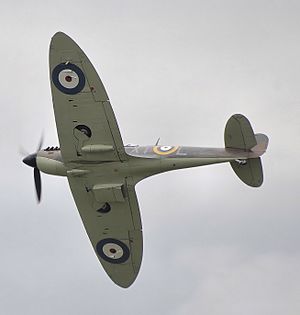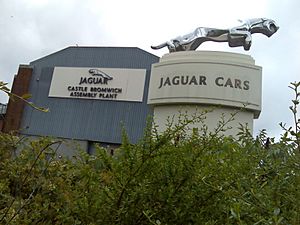Castle Bromwich Assembly facts for kids
Castle Bromwich Assembly is a large factory owned by Jaguar Land Rover. It's located in Castle Vale, Birmingham, England. About 3,200 people work there. The factory sits on a huge piece of land, about 110 acres (45 hectares), with a manufacturing building that's 60,000 square meters big. This plant is where all Jaguar saloon (sedan) and sports cars are made.
The site first started as the Castle Bromwich Aircraft Factory. It was a special "shadow factory" built to make airplanes during the time leading up to World War II. After some early challenges, it became one of the biggest airplane factories during the war.
Contents
History of the Factory
Making Airplanes for World War II
Building Aircraft: 1936–1940
In 1936, the British government created a plan called the "Shadow Factory Plan." The idea was to build new factories and expand existing car plants. This would allow them to quickly switch to making airplanes if a war started. Herbert Austin, a famous car maker, led this plan.
The government bought land near the Castle Bromwich Aerodrome in 1936. The Nuffield Organization, which owned Morris Motors, was put in charge of building and running the factory. Their main job was to build Supermarine Spitfire fighter planes and later Avro Lancaster bombers. The government hoped that the skilled workers and production methods used for cars in Birmingham could also be used for airplanes.
The factory ordered the newest machine tools available. Even though Morris Motors was in charge, the government paid for everything. The factory was supposed to cost £2 million, but by 1939, it had cost over £4 million. Making Spitfires was tricky because they used a special "stressed-skin" design. This needed very precise engineering skills that the local workers had to learn.
Airplanes were moved across the road to the aerodrome for testing. Large buildings called 'Flight Sheds' were used to get the planes ready for their first flights. Alex Henshaw, a skilled test pilot, led a team of pilots who tested the aircraft. They tested planes almost every day, even in bad weather, to make sure they were safe.

The Castle Bromwich factory made many different versions of the Spitfire, starting with the Mk II. This version had a more powerful Rolls-Royce Merlin XII engine.
However, in June 1940, the factory was still not finished, and there were many problems with how it was managed. Workers also asked for higher pay. By May 1940, the factory hadn't built its first Spitfire, even though it was supposed to be making 60 per week. Alex Henshaw, the chief test pilot, believed the main problems were due to poor management at the start.
Vickers-Armstrong Takes Over: 1940–1945
After a change in government, Winston Churchill appointed Lord Beaverbrook as the Minister of Aircraft Production. In May 1940, Beaverbrook took control of the Castle Bromwich plant from Nuffield. He found that expensive machines were not being used, the assembly line was messy, and workers were not always doing their jobs.
Beaverbrook then cancelled all bomber contracts for Castle Bromwich. He sent in experienced managers and workers from Supermarine, the company that designed the Spitfire. Control of the factory was given to Vickers-Armstrong, Supermarine's parent company.
Even though it took time to fix the issues, the factory started full production in June 1940. They built 10 Spitfire Mk IIs that month, then 23 in July, 37 in August, and 56 in September. The first squadron to get the Mk II was No. 611 Squadron RAF in August 1940, which was late for the Battle of Britain.
The importance of the shadow factory plan became clear in September 1940. The original Supermarine factory in Southampton was bombed, stopping production there. Castle Bromwich then became the largest and most successful aircraft factory during the war. It built over half of all Spitfires made, producing up to 320 planes each month. By June 1945, when production ended, the factory had built 12,129 Spitfires.
The factory also built Avro Lancaster bombers. The first Lancaster made at Castle Bromwich flew in October 1943. Production of Lancasters reached its highest point in December 1944, with 25 bombers made.
Today, you can still see some original wartime features at the factory. For example, there are faded remains of green camouflage paint on some older buildings. If you look closely, you might also see a winged-roundel symbol (like the RAF symbol) on the factory's drainpipes. In 1997, a special plaque was put up at the factory gates. During the ceremony, a Spitfire that was built and test-flown by Alex Henshaw himself flew over the event.
From Aircraft to Cars: 1945 to Today
Post-War Car Production: 1945–1977
After the war, the factory was taken over by Fisher and Ludlow. This company made car body parts for many British car brands. Later, Jaguar took full control of the factory in 1977.
Jaguar Land Rover Era: 1977 to Present
The factory became part of Ford Motor Company when Ford bought Jaguar in 1990. Then, in 2008, it became part of Tata Motors as part of Jaguar Land Rover.
After the takeover, Tata Motors considered closing either the Castle Bromwich plant or the Land Rover plant in Solihull. However, in October 2010, an agreement was reached between Jaguar Land Rover and the Unite the Union. This deal saved all three Jaguar Land Rover production plants from closing until at least 2020.
In 2019, workers at the plant voted to switch to a four-day work week. This was part of a plan to help the factory attract new car models and keep jobs safe. This was important because production of the XJ car was ending.
Soon after, in July 2019, Jaguar Land Rover announced exciting news: they would build a new electric XJ saloon at Castle Bromwich! This decision helped protect the jobs of about 2,500 people. The company planned to invest £1 billion to upgrade the factory for the new electric car. This new electric model was very important for the factory's future.
Cars Made Here
The Castle Bromwich plant handles many steps in car making. This includes shaping the car bodies, putting them together, painting them, and the final assembly. Over 3,000 workers build thousands of cars here for the UK and for export to other countries.
- Jaguar XE
- Jaguar XF
- Jaguar F-Type
Past Car Models
The following Jaguar models were built at the Castle Bromwich plant until their production ended:
- Jaguar XK
- Jaguar XJ
- Jaguar S-Type
Images for kids



